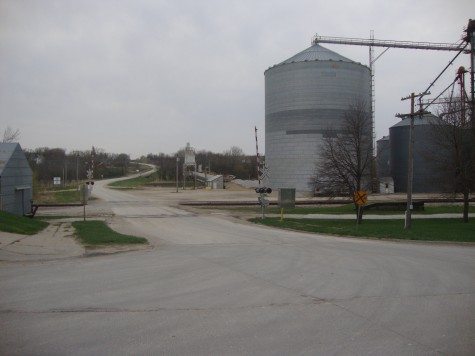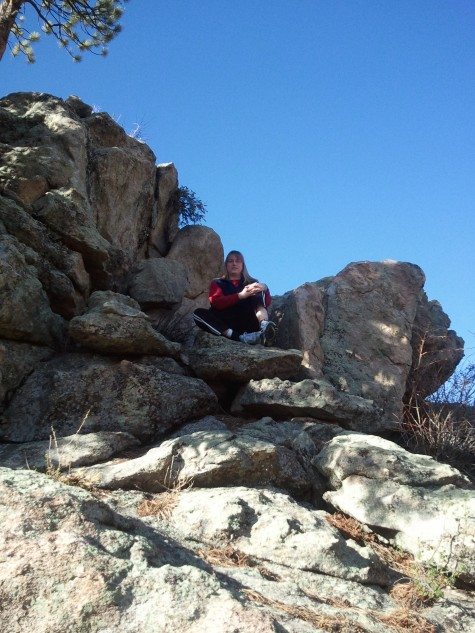It’s right there in my byline, GeekMoms! Ask her why the sky is blue at your own risk. I say that because sometimes my answers to weather questions might make your eyes roll. I probably look like Brainy Smurf, complete with my right forefinger up in the air, being a serious know-it-all…

GeekMom Judy took the risk back in 2011, except she didn’t ask “Why is the sky blue?” She asked about why the sky isn’t as blue in New York as it seemed to be in Utah or Colorado. Being the awesome GeekMom she is, she even presented a very accurate hypothesis.
“Someone once told me that the humidity in the air determines how blue the sky is. I always thought that was an old wives’ tale. But the longer I live here, and the more I look at the pictures we took in Colorado recently (on our house hunting trip), the more I’m convinced that the states with low humidity have much bluer skies.
Is this true? Does humidity affect the depth of blue that the sky appears to be? Or am I imagining things and buying into the wives tale?”
It is true that the humidity in the air will contribute to the blueness of sky over our heads, especially in the east where the Appalachian Mountains are acting as a barrier for the Gulf of Mexico and Atlantic Ocean humidity.
Are you ready to delve into why the sky is (and isn’t) blue? Strap in, here we go! Stay tuned, GeekMom Helene also provided us an experiment to share this with the kids!
Rayleigh scattering. Here is the official answer to “Why is the sky blue?” It’s the scattering of light (or any electromagnetic radiation) by particles smaller than the wavelengths being scattered. The intensity of the scattering is inversely proportional to the wavelength. Air in our atmosphere is mostly nitrogen and oxygen, with a little bit of argon. Those values are pretty consistent worldwide and consistently will scatter the blue wavelengths the greatest, giving us our blue skies. In reality, all the colors in the visible spectrum are being scattered, but the strongest scattering is in the blue-violet part of the spectrum.
Without actually looking at the sun, we all know that near the sun we see yellow/orange as there’s a more intense amount of light coming straight from the sun’s direction towards our eyes and more of the blue/violet is scattered elsewhere. As the sun sets, more of the blue/violet spectrum is scattered away as there’s more atmosphere between our eyes and the sun… leaving us the red/orange hues.
Mie Scattering. Now let’s talk about what happens when water droplets/water vapor/humidity—among other things—come into play.
This is where I got all Brainy Smurf on the GeekMoms. Let’s introduce three contributors to the hazy skies east of the Mississippi:
1. Pollution. The eastern United States has more concentrated populations and has a tradition of concentrated areas of manufacturing that still exists today. Therefore, expect increased pollutants in the air and those act similarly to the water molecules serving to scatter light in colors other than the blue wavelength.
2. Isoprene/Terpene. The varieties of trees in the eastern United States is known for emitting an organic compound known as “isoprene” (also might be called “terpene”, they are the same compound). Oaks and poplars are two of the most prolific isoprene producers, and this compound is what gives the Blue Ridge Mountains their namesake bluish-colored haze.
3. Atlantic Ocean/Gulf of Mexico. The impacts of the Atlantic Ocean and Gulf of Mexico contribute to much of the haze obscuring the sky between the Appalachians and the coastline. The haze can develop not only from the water vapor that can travel inland, but also the salt particles.
In “Mie Scattering,” we are talking about the behavior of light waves/particles when the size of the scatterer is comparable to or larger than the wavelength of the light. So in the case of the atmosphere east of the Appalachians, the scatterers in question include water vapor, isoprene molecules, and all those pollutants (such as sulfate aerosols from sulfur dioxide). Each of those scatterers will act differently—scattering the light at assorted wavelengths.
What happens when a wide range of scatters are emitting at assorted wavelengths?
White light! Hence the whitish appearance to the sky.

But strip out all that water vapor, organic compounds, and pollutants, and you get this fantastic sky in Colorado!

If you’d like to learn more about haze in the eastern United States, I will now refer you to Steve Corfidi’s paper on the topic from 1996. Mr. Corfidi is a forecaster for the National Weather Service’s Storm Prediction Center—the agency that issues the Severe Thunderstorm and Tornado Watches—but has had a fascination with haze from growing up in Baltimore.
GeekMom Helene has a kids’ experiment that easily demonstrates the effects of introducing scatters.
GeekMom Helene’s Blue Sky Experiment
Materials: Flashlight, drinking glass, eye dropper, water, milk, spoon
Procedure:
1) Fill glass with water
2) In a darkened room, direct the flashlight through the side of the glass and through the water.
3) Observe the color of the water
4) Add 1 drop of milk to the water and stir.
5) Again shine the light through the water.
6) Observe the color of the water.
Result: The light passes through the clear water, however the milky water has a light blue-ish tint.
Explanation: The waves of color that make up white light are actually many different sizes (wavelengths). The particles of milk in the water are small enough to block and reflect the blue light waves. Those waves are bounced around and cause the predominant light that we see coming from the milky water. Nitrogen and oxygen in the Earth’s atmosphere are also small enough to separate out the blue light waves from sunlight. The blue light scatters throughout the entire atmosphere making the sky look blue from the ground, and the Earth look blue from space.
The color in the milky glass isn’t perfectly blue because milk contains molecules of several different sizes, and larger molecules are also reflecting light. This same phenomena happens in the atmosphere when large amounts of dust and water vapor scatter more than just the blue light waves. Clean, dry air, free of dust and water vapor, scatters the most blue waves.




Thank you! I always wondered why even on a clear day in Japan, the sky just didn’t look as blue as when we go back to Utah. It’s the humidity(and probably some extra pollution)! You’ve been a great help.
You’re very welcome! Glad we could help! Have a great day!
Thanks for this explanation! I’ve always lived in the West, and currently live in Utah, so I take the deep blue sky for granted. I once saw author Will Hobbs speak, and he was talking about his books (set in the west) and showing slides. While showing a gorgeous photo of red rock country with a vivid blue sky, he noted that he has been questioned by eastern youth “what is that blue?” The little anecdote stuck with me, but it seemed more of an apocryphal tale, one designed to scare us adults into getting kids outdoors more, or they won’t even know that the sky is blue. He did explain that the sky isn’t that blue on the east coast, but that just seemed weird!
Valerie: I grew up on the East Coast. I can understand those eastern kids completely. I did not spend any time west of the Mississippi from age 7 (when we moved from Hawaii to Virginia) until college.
I don’t remember paying attention to the sky much before we got to Virginia, so when I took a trip to Arizona my junior year of college, and to Montana between my junior year and senior year…I was awestruck not just the blueness of the sky, but also how VIVID the mountains looked even though they were 50 miles away!
You can’t see anything more than about 20 miles away in the Appalachians! The haze will wash it out.
I meant to put quotes around that 2nd paragraph, sorry.
What about the effect of elevation? I’ve noticed the sky get bluer the higher one goes up a mountain.
The higher up you are, the less scatterers there will be in general. You might argue that you could be on a mountaintop above the pollutants and humidity (Mt. Washington, New Hampshire?). And then I’d expect the sky to be more blue…with even perhaps an observation of violet as the average wavelength of the small scatters becomes shorter.
Also, if you’ve ever seen footage of — or perhaps experienced if you’re a high altitude pilot or astronaut, grin — the “top” of our atmosphere, you can see what happens when the scatterers peter out altogether. The sky transitions from blue to deep violet to no color at all.
Thanks! This is a fabulous explanation. I live in California, but have lived in the midwest and New England, and I have a fondness for all tints of blue! This article has a great experiment for my daughter’s preschool to do together, too.
Living in Los Angeles, I see a lot of not-blue sky here. And now I know why! Thanks!
This explains a memory from my youth. I’m from Texas, so very blue skies were the norm for me, however in high school I was lucky enough to go on a trip to Europe. My group was traveling with some college kids form Michigan. I t was March, so very ray alot of the time, however we came out of a tour in Grasse to find the sky looking just like home. A nice boost for us, but not a huge thing, however our Michigan companions were taking pictures of the sky They said they’d never seen one that blue.
I just got back from Colorado and Utah, and thought of your post so many times, as I couldn’t stop taking pictures of ‘the sky’, as Ellen said. The deep blue makes the mountains and clouds just look spectacular every single day, not to mention making the sunsets ‘photo worthy’ every single days.
Great post, Patricia! It was fun seeing my pictures up there. And now I know I’m not crazy because I’ve always sworn to my NY friends that the sky is bluer out west!
Judy
Thank you for a great post! I was in a remote part of Nevada this summer and have never seen a bluer sky. I am wondering about Mars and the salmon color sky. Does the distance from the sun have anything to do with the color of the sky? Or is it simply the carbon dioxide atmosphere? Thanks!
I got my answer from this website: http://www.webexhibits.org/causesofcolor/14C.html
If the Martian atmosphere were free of dust, the daytime sky would appear blue, because of Rayleigh scattering by the molecules (primarily carbon dioxide) that make up the atmosphere. Because the atmosphere is thinner than earth’s atmosphere, the Martian sky would be a darker blue than ours, much as the sky on earth appears at high altitudes with a similar density of air molecules. It is possible (though unlikely) that future missions to Mars will find a different sky color.
The dust scatters the reddish colors and absorbs a lot of the blue wavelengths.
Disqus test for Maryann.